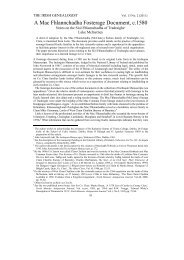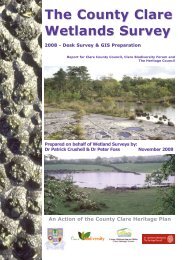A Statistical Analysis of Ringfort Distribution and Morphology on the ...
A Statistical Analysis of Ringfort Distribution and Morphology on the ...
A Statistical Analysis of Ringfort Distribution and Morphology on the ...
You also want an ePaper? Increase the reach of your titles
YUMPU automatically turns print PDFs into web optimized ePapers that Google loves.
Chapter 1: Introducti<strong>on</strong><br />
was partly in resp<strong>on</strong>se to Clarke’s own work <strong>on</strong> <strong>the</strong>oretical modelling in archaeology, al<strong>on</strong>g with <strong>the</strong><br />
development <str<strong>on</strong>g>of</str<strong>on</strong>g> Chisholm’s ‘Catchment Area’ c<strong>on</strong>cept by Vita-Finzi <str<strong>on</strong>g>and</str<strong>on</strong>g> Higgs. 1<br />
In Analytical Archaeology, Clarke describes technical developments borrowed <str<strong>on</strong>g>and</str<strong>on</strong>g> adapted from o<strong>the</strong>r<br />
disciplines <str<strong>on</strong>g>and</str<strong>on</strong>g> outlines various means by which <strong>the</strong>y may be applied to archaeological data. 2 In <strong>the</strong><br />
posthumously published Spatial Archaeology Clarke, in a series <str<strong>on</strong>g>of</str<strong>on</strong>g> essays, sets out a <strong>the</strong>oretical<br />
framework for <strong>the</strong> discipline, but laments that <strong>the</strong> growth <str<strong>on</strong>g>of</str<strong>on</strong>g> spatial analysis has been dogged by<br />
inadequate research <str<strong>on</strong>g>and</str<strong>on</strong>g> its slow acceptance by archaeology as a whole:<br />
‘It has ... been as characteristic <str<strong>on</strong>g>of</str<strong>on</strong>g> this area <str<strong>on</strong>g>of</str<strong>on</strong>g> archaeological disciplinary<br />
development as any o<strong>the</strong>r that important steps in <strong>the</strong> retrieval <str<strong>on</strong>g>of</str<strong>on</strong>g> informati<strong>on</strong> from<br />
spatial relati<strong>on</strong>ships in archaeological c<strong>on</strong>texts have been dispersed, disaggregated<br />
<str<strong>on</strong>g>and</str<strong>on</strong>g> dissipated ... In additi<strong>on</strong>, <strong>the</strong> analyses <str<strong>on</strong>g>of</str<strong>on</strong>g> spatial informati<strong>on</strong> in archaeology for a<br />
l<strong>on</strong>g time tended to remain ei<strong>the</strong>r inexplicit, intuitive, static <str<strong>on</strong>g>and</str<strong>on</strong>g> typological, or at<br />
best a sec<strong>on</strong>dary aspect <str<strong>on</strong>g>of</str<strong>on</strong>g> studies devoted to o<strong>the</strong>r objectives.’ 3<br />
The previous year saw <strong>the</strong> publicati<strong>on</strong> <str<strong>on</strong>g>of</str<strong>on</strong>g> Hodder <str<strong>on</strong>g>and</str<strong>on</strong>g> Ort<strong>on</strong>’s Spatial <str<strong>on</strong>g>Analysis</str<strong>on</strong>g> in Archaeology. 4 In<br />
<strong>the</strong>ir introducti<strong>on</strong>, <strong>the</strong> authors state that <strong>the</strong> central <strong>the</strong>sis <str<strong>on</strong>g>of</str<strong>on</strong>g> <strong>the</strong>ir work ‘is to suggest to<br />
archaeologists that <strong>the</strong>re is a potential for more detailed <str<strong>on</strong>g>and</str<strong>on</strong>g> systematic study <str<strong>on</strong>g>of</str<strong>on</strong>g> spatial pattering in<br />
archaeological data.’ 5 This is arguably <strong>on</strong>e <str<strong>on</strong>g>of</str<strong>on</strong>g> <strong>the</strong> most important published works <strong>on</strong> spatial<br />
relati<strong>on</strong>ships, not merely because it, for <strong>the</strong> first time, c<strong>on</strong>centrated solely <strong>on</strong> spatial analysis, but<br />
also that it enlarged <str<strong>on</strong>g>and</str<strong>on</strong>g> developed Clarke’s adopti<strong>on</strong> <str<strong>on</strong>g>of</str<strong>on</strong>g> quantitative <str<strong>on</strong>g>and</str<strong>on</strong>g> statistical techniques from<br />
o<strong>the</strong>r disciplines <str<strong>on</strong>g>and</str<strong>on</strong>g> outlined <strong>the</strong>ir applicati<strong>on</strong> to archaeological data.<br />
However, it would be misleading to suggest that <strong>the</strong> statistical <str<strong>on</strong>g>and</str<strong>on</strong>g> spatial approach to archaeology<br />
was universally <str<strong>on</strong>g>and</str<strong>on</strong>g> readily accepted within <strong>the</strong> pr<str<strong>on</strong>g>of</str<strong>on</strong>g>essi<strong>on</strong>. As menti<strong>on</strong>ed above Clarke indicated<br />
some <str<strong>on</strong>g>of</str<strong>on</strong>g> <strong>the</strong> problems within this field <str<strong>on</strong>g>of</str<strong>on</strong>g> specificati<strong>on</strong>. 6 O<strong>the</strong>r commentators were more forceful in<br />
decrying <strong>the</strong> apparent ‘invasi<strong>on</strong>’ <str<strong>on</strong>g>of</str<strong>on</strong>g> archaeology <strong>the</strong> scientific <str<strong>on</strong>g>and</str<strong>on</strong>g> statistical techniques champi<strong>on</strong>ed by<br />
‘new archaeology.’ 7<br />
Rosse’s study <str<strong>on</strong>g>of</str<strong>on</strong>g> Neolithic <str<strong>on</strong>g>and</str<strong>on</strong>g> Br<strong>on</strong>ze Age m<strong>on</strong>uments <str<strong>on</strong>g>of</str<strong>on</strong>g> Wales centres <strong>on</strong> <strong>the</strong> ec<strong>on</strong>omic<br />
determinants <str<strong>on</strong>g>of</str<strong>on</strong>g> <strong>the</strong> locati<strong>on</strong> <str<strong>on</strong>g>of</str<strong>on</strong>g> various sites <str<strong>on</strong>g>and</str<strong>on</strong>g> communities. He notes that <strong>the</strong> success that such<br />
groups achieved was dependent <strong>on</strong> a multitude <str<strong>on</strong>g>of</str<strong>on</strong>g> interrelated ec<strong>on</strong>omic variables. Am<strong>on</strong>g <strong>the</strong>se he<br />
includes relief, topography <str<strong>on</strong>g>and</str<strong>on</strong>g> water supply al<strong>on</strong>g with vegetati<strong>on</strong>al <str<strong>on</strong>g>and</str<strong>on</strong>g> geographical factors. 8<br />
Davids<strong>on</strong>’s investigati<strong>on</strong> <str<strong>on</strong>g>of</str<strong>on</strong>g> <strong>the</strong> isl<str<strong>on</strong>g>and</str<strong>on</strong>g> <str<strong>on</strong>g>of</str<strong>on</strong>g> Rousay in <strong>the</strong> Orkneys indicated that, in tomb locati<strong>on</strong>,<br />
paramount importance was given to <strong>the</strong> twin c<strong>on</strong>siderati<strong>on</strong>s <str<strong>on</strong>g>of</str<strong>on</strong>g> access to <strong>the</strong> sea <str<strong>on</strong>g>and</str<strong>on</strong>g> <strong>the</strong> availability<br />
<str<strong>on</strong>g>of</str<strong>on</strong>g> a comm<str<strong>on</strong>g>and</str<strong>on</strong>g>ing locati<strong>on</strong>. He also c<strong>on</strong>cludes that <strong>the</strong> tomb builders were not influenced by <strong>the</strong><br />
quality <str<strong>on</strong>g>of</str<strong>on</strong>g> <strong>the</strong> available soils to anything approaching <strong>the</strong> same extent as appears to be <strong>the</strong> case in<br />
Wales. 9<br />
As part <str<strong>on</strong>g>of</str<strong>on</strong>g> Faull <str<strong>on</strong>g>and</str<strong>on</strong>g> Moorhouse’s archaeological survey <str<strong>on</strong>g>of</str<strong>on</strong>g> West Yorkshire <strong>the</strong>y c<strong>on</strong>sider apparently<br />
nucleated settlements which are known to have existed before 1086 <str<strong>on</strong>g>and</str<strong>on</strong>g> <strong>the</strong>ir relati<strong>on</strong>ships to <strong>the</strong><br />
1 Clarke 1968; 1972; Chisholm 1968; Vita-Finzi <str<strong>on</strong>g>and</str<strong>on</strong>g> Higgs 1970.<br />
2 Clarke 1968.<br />
3 Clarke 1977, 4-5.<br />
4 Hodder & Ort<strong>on</strong> 1976.<br />
5 Op. cit. 1.<br />
6 Clarke ibid.<br />
7 cf Hawkes 1968.<br />
8 Rosse 1979 cited in Henry 1989, 107.<br />
9 Davids<strong>on</strong> 1979.<br />
4
















